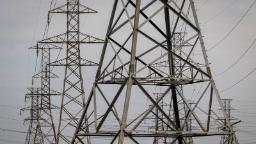

A version of this story appears in CNN’s What Matters newsletter. To get it in your inbox, sign up for free here.
CNN
—
Power problems in Texas seem relatively frequent in recent years. Cold snaps, heat waves, freak storms – any of them can tax the state’s independent power grid, which is largely cut off from the rest of the country.
This week, it was a heat wave – triple-digit temperatures – and a tornado that had the state’s power authority, the Electric Reliability Council of Texas, asking residents to cut power consumption and turn up their thermostats.
Note: This week, according to the website PowerOutage.us, outages continue in parts of Texas, Oklahoma and Louisiana for a variety of reasons.
In Texas, it was a predictable development, since pretty much the same thing happened last May, and forecasters had already been predicting elevated temperatures this year.
But the timing of ERCOT’s appeal to Texans to turn up their thermostats was awkward for Texas Gov. Greg Abbott.
Among the more than 70 bills passed by the legislature that Abbott recently nixed in order to force consideration of an unrelated property tax issue was a bipartisan one to improve energy efficiency standards for new buildings.
While the bill obviously wouldn’t have cut energy consumption this week, its veto is a tell about the governor’s priorities – which clearly lean more toward reducing taxes than increasing energy efficiency, despite the state’s annual power grid issues.
“This is Texas’ new reality,” writes the Houston Chronicle in an editorial criticizing Abbott for the veto. “The number of 100-degree days in our state is expected to nearly double by 2036. Combine that with a booming population in a state that already accounts for one-seventh of the nation’s total energy consumption, and you can expect ERCOT to shatter peak energy demand records for years to come.”
The Chronicle argues Texas should be looking for every little bit of efficiency it can find. The kind of efficiencies found in new building codes with bipartisan support represent the low-hanging fruit.
A summer outlook for the US power grid published in May by the North American Electric Reliability Corporation suggested Texas, along with most of the country, could encounter problems if temperatures rise above average this summer.
“Resources are adequate for peak demand of the average summer; however, dispatchable generation may not be sufficient to meet reserves during an extreme heat-wave that is accompanied by low winds,” is how the report phrases the outlook for Texas.
The probability, the assessment also notes, is for Texas – more so than the rest of the country – to experience above-normal temperatures this summer.
The grid was strained due to high heat even before a string of unexpected circumstances struck. Things like:
- The tornado that took out a substation in the small town of Matador, likely leaving residents there without power until Friday or Saturday.
- Or the Texas nuclear plant that stopped producing electricity last Friday due to problems with a feed water pump.
- Or the burst of freak storms that hit Houston Wednesday night, leaving more than 100,000 people without power Thursday afternoon.
RELATED: The North Atlantic is experiencing a “totally unprecedented” marine heat wave
Officials in Texas are well aware of the risk the heat poses to their power grid and have used that threat to argue for more carbon-emitting natural gas-generated power rather than renewables, which ebb and flow with sunlight or wind.
While ERCOT, in asking the public to drive down demand, said the overall power grid was never in danger as a result of the heat wave, it cited a few reasons for the request that Texans cut back on consumption, including:
- Extreme heat and record demand.
- “Thermal outages,” which suggests issues with some natural gas-fired power plants.
- Lower-than-expected generation of wind power.
- The daily ups and downs of solar power generation.
The vast majority of power in Texas is generated by natural gas, although an increasing amount comes from renewable sources like solar and wind.
“Texas is, by rhetoric, anti-renewables. But frankly, renewables are bailing us out,” Michael Webber, an energy expert and professor at the University of Texas at Austin, told CNN’s Ella Nilsen last June, when the state was in the same situation it finds itself in this summer. “They’re rocking. That really spares us a lot of heartache and a lot of money.”
President Joe Biden appeared in Northern California this week to talk about his climate agenda, which includes money Democrats voted to earmark to help modernize the electrical grid and encourage the transition to more renewable energy sources.
Former President Donald Trump, by contrast, was outright hostile to these forms of renewable energy.
Most Americans are much more open to renewable energy – 66% in a Pew Research Center survey conducted in March said the federal government should be doing more to encourage rather than discourage wind and solar power production.
But that openness to renewable energy does not suggest opposition to carbon-emitting sources of energy. Americans are not as supportive of the government encouraging oil and natural gas drilling or coal mining, but majorities do not feel the government should discourage it either.
